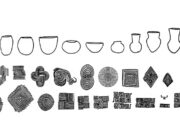Next to stone tools and stone debris, pieces of pottery vessels are the most common evidence of the former Indian occupation of Georgia. American archaeologists call these pottery pieces sherds (not shards) and have been studying them for well over 100 years. Despite general similarities in Georgia Indian pottery through time, many differences have been noted. To date, more than 400 named types have been used by archaeologists to describe the Indian pottery of Georgia. Because many of these names are redundant or obsolete, however, perhaps 100 types now account for all normal varieties of pottery from Georgia’s prehistory.
Even though all Indian pottery is open-fired earthenware made at a low temperature, there were many variations of the paste formula. The earliest pottery in Georgia—and in the United States—is fiber-tempered, so called because it was made of a paste formed by mixing, or tempering, Spanish moss with clay. This early pottery dates to perhaps 4,500 years ago. Most Indian pottery from Georgia was made of paste that was tempered with common sand. Tempering simply allows the paste of a newly formed pot to dry adequately before firing. A pot made of pure clay will often explode in the firing process when moisture escapes as steam. Other tempering agents used by Georgia Indians included crushed or ground shell and crushed limestone.
Although many pottery vessels were simple undecorated cooking vessels, others were decorated using a variety of techniques. The first and perhaps most important decorative technique used by Georgia Indians was the use of wooden paddle stamps with different designs carved on their surfaces. Makers imparted the designs to the vessel surface by striking the soft, wet vessels with the carved paddles. This style of decoration was rare in the native ceramics of most parts of the world, but it was an important tradition in Georgia Indian ceramics for almost 2,500 years. Another important decoration method included designs incised or drawn in the wet clay with tools of wood or bone. Some of these designs were quite elaborate. Red and sometimes black or white paint was also used to decorate vessels. Some vessels had their outsides “decorated” with paddles wrapped in small or large string or a simple burlaplike fabric.
The forms of vessels ranged from simple straight-sided pots with rounded bases to large excurvate rim jars to rounded incurving bowls. Most cooking pots were about twelve inches high and the same distance across.
Archaeologists find that pottery is one of the most sensitive indicators of time, and they have used it to construct most of the chronologies for the last 4,500 years in Georgia prehistory and early history. An unusual aspect of Georgia pottery production is that the Indians evidently did not use it as a means of expressing themselves. Since most pottery was probably made by women, young girls would undoubtedly have done their best to emulate accurately their mothers’ lessons on the correct way to make a pot.




